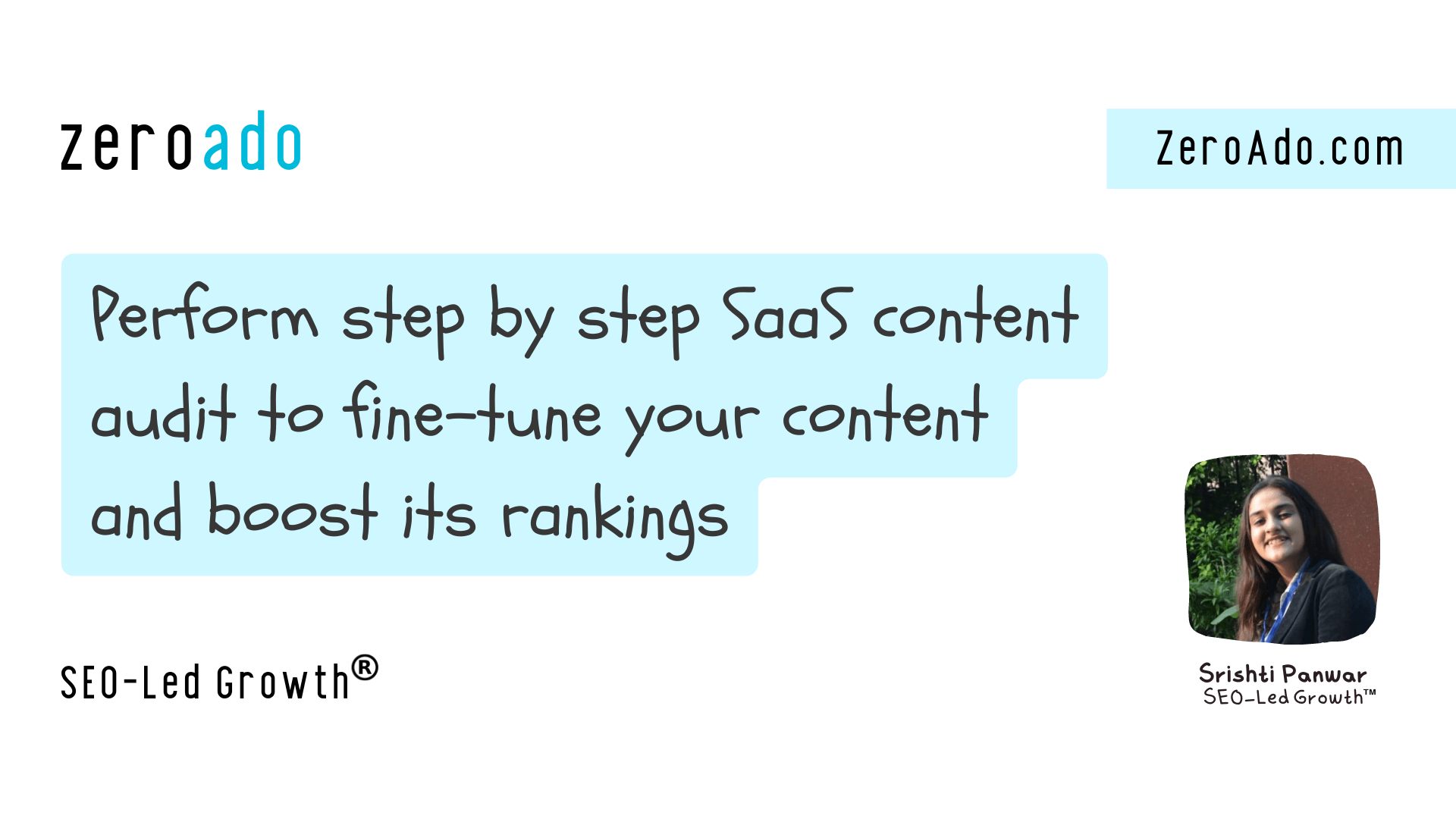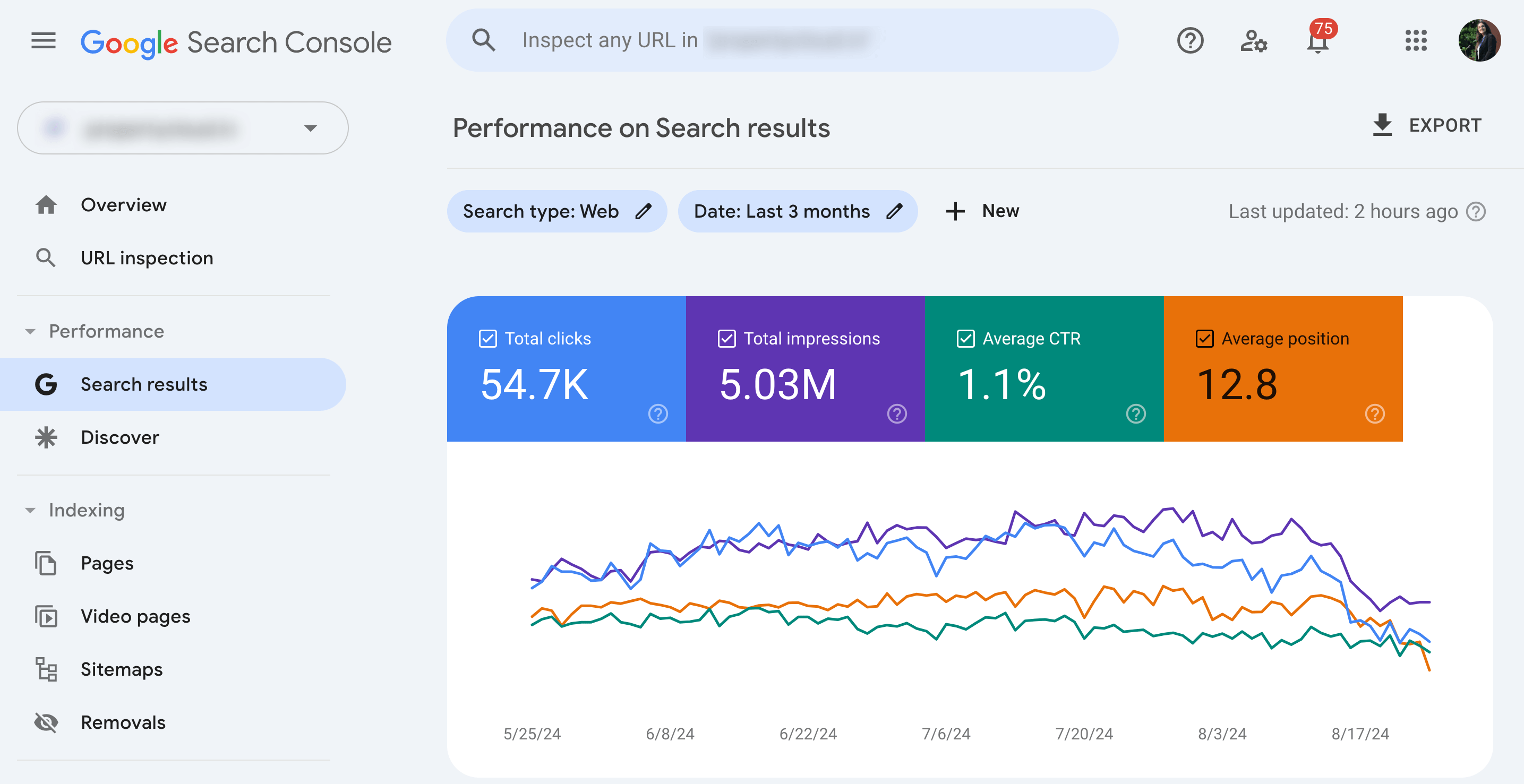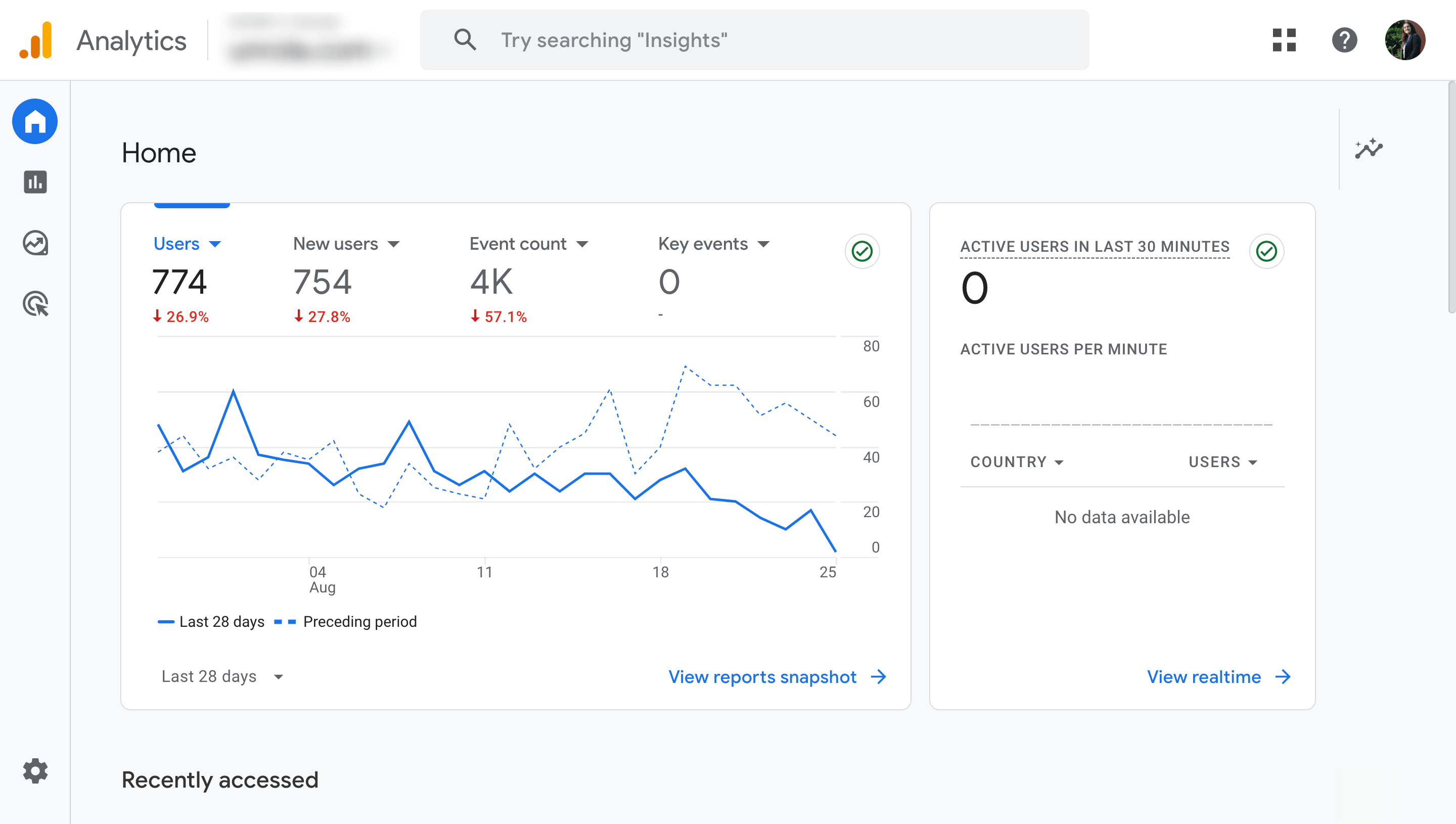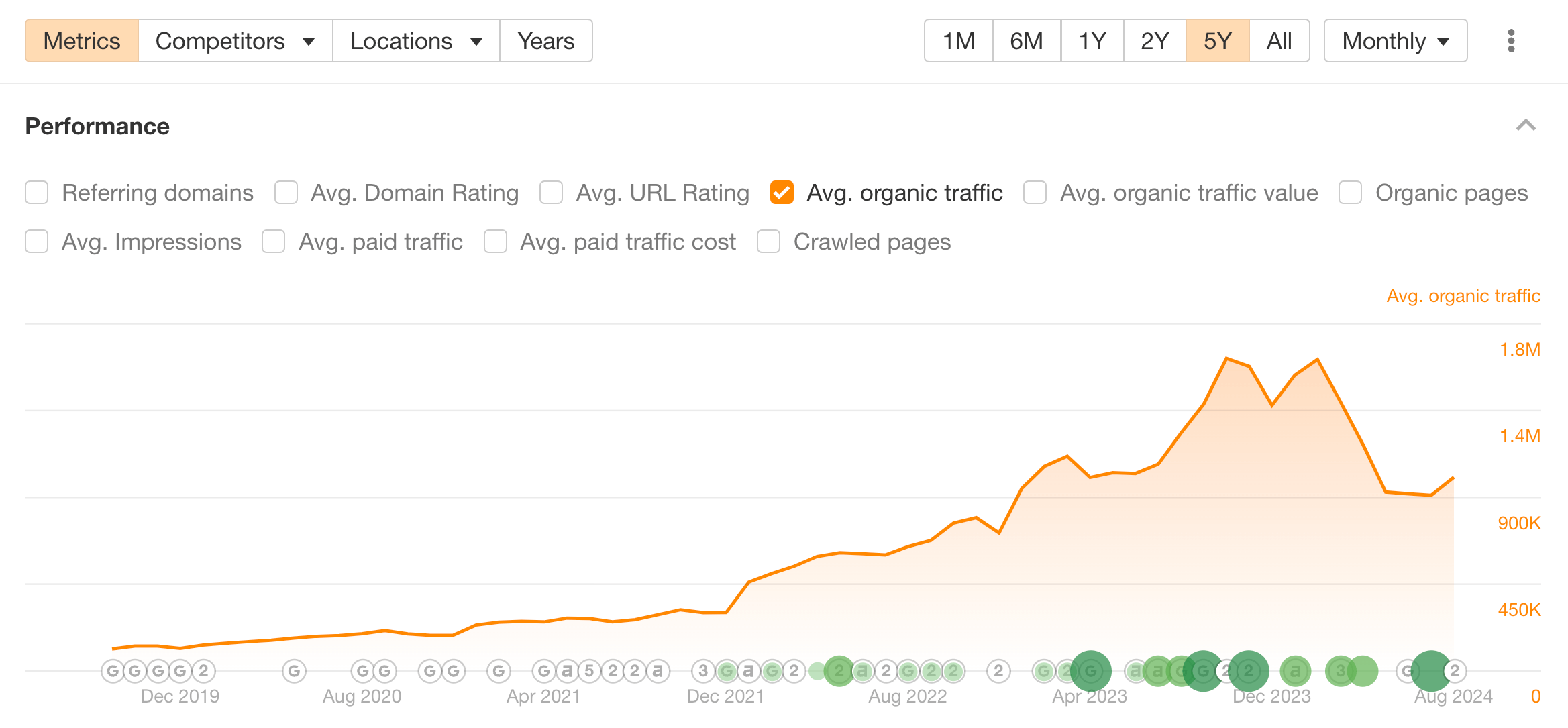
You see those metrics above? That is the organic traffic of a SaaS brand called ClickUp, which is an AI based project management tool. They had an aggressive SaaS content marketing strategy and what I found even more aggressive was their SaaS content audit.
The fact that they audited every piece of content almost to perfection before publishing it, tells me the drive they had to make their content strategy succeed.
“Oh but how do you know that?”
I knew you were gonna ask me that, I have my defense ready. I know that because I have been in the content marketing industry for half a decade now and the way ClickUp scaled was uncanny! Also, if you read any piece of content from them, you will know that each one leaves you wondering ‘wow’ and with a thought of wanting to try their product.
That kind of content can only be published because of a thorough content audit for SaaS. Every SaaS brand needs to do that to make their content perform, including yours and thus, that is what we are going to discuss today.
- SaaS content audit – What is it and why is it needed?
- Who should conduct a SaaS content audit
- SaaS content audit – A step-by-step guide
- Select KPIs to analyze existing content
- Crawl your content and create an inventory with metrics
- Analyze the type of content you have and set fields to audit for each
- Make inventory filterable and analyze the action points for each content URL
- Set priorities
- Maintain a document for detailed action points for all content types
- Follow ZeroAdo’s content quality checklist
- Get, set, do SaaS content audit!
SaaS content audit – What is it and why is it needed?
SaaS content audit refers to the process of reviewing and updating your existing or new content to perform better and also to answer the queries your audience and probable customers have.
This audit is done to make sure that the content is SEO optimized so it can rank while also being helpful content for the user since that is what Google prioritizes.
But why is SaaS content audit important?
I was hoping you would ask that question. Here are all the reasons why you need to audit your SaaS content before taking it live and also post taking it live as well.
- To make sure that you are pushing only quality content. If you are confused about how to assess the quality, then utilize ZeroAdo’s Content Quality Guidelines®.
- To keep increasing the engagement on the content you are publishing, you need to update it regularly based on the insights you gather from Google Search Console.
- To update your SEO content and SEO strategy based on the performance of various pieces of content so you can get maximum benefits.
- To increase ROI and get maximum qualified leads from the content you are publishing.
- To keep your content relevant as per the new information that keeps coming up.
Who should conduct a SaaS content audit
Every single SaaS business must do a content audit for SaaS to know where they stand in the market, how they are being viewed by their customers, and how they compare to their competitors.
A content marketing expert can consult this audit for your brand, or you can give the entire burden of leveling up your content to any one of the SaaS content marketing agencies out there.
However, keep in mind that this is a high value task and your business’s progress is at stake, thus a content audit must be done by the experts only.
SaaS content audit – A step-by-step guide
SaaS content audit must be conducted for both the existing content and also the content you are planning to publish next. Here I am sharing the tips on how you can audit and update your old content and how you can get things right in the first step itself from your new content.
Select KPIs to analyze existing content
The best point to start a content audit is to replenish the existing content. Pick up your current strategy, and find out the KPIs you had set before publishing the content.
These key performance index could be anything, ranging from position of your content pieces on Google Search to the number of clicks they have got. They are based on the goals you have for your content marketing and SEO together to have sustainable business growth.
These KPIs could be easily found in your Google search console or in your Google Analytics dashboard based on the SaaS marketing metrics you are tracking.
Crawl your content and create an inventory with metrics
Now that you have your existing strategy handy, along with the KPIs you want to analyze, it’s time you crawl your entire existing content and create an inventory of it. In that inventory, add your KPI fields. I would ideally add the following along with the comparison from the time frame.
- Number of clicks each URL got
- Position of the content on Google search
- CTA or pop-ups clicks
- Sign Ups
Compare the current data with the previous period of the same time frame. You can do these audits week-on-week, month-on-month, or even quarterly, based on your business’s bandwidth.
Based on these KPIs you are then going to find out the content to update. Here is how you are going to find the content to update.
➡️ Is your content piece getting traffic? If yes then keep it in the pipeline, if no then check if it has any backlinks, or if there is any duplicate content or if there are any indexing issues.
➡️ Now, check the position of the URL getting traffic, if it is on page 1 and 2 and getting decent traffic, then it is time to update it to improve the position. If not, then figure out how you can make your content better than the top ranking content pieces.
➡️ Please note that not all content pieces will always get top-notch traffic. Some content might be in the bottom when it comes to metrics, but that might be a pillar of content that is getting traffic to others. So make sure to check that before taking any drastic step.
➡️ Always focus on updating your content to make it better, instead of deleting or archiving it.
Get your list of content pieces ready, we will now be auditing them, 1 on 1.
Analyze the type of content you have and set fields to audit for each
In your list, I am certain that there are going to be different types of SEO content that you need to update. Ideally this list should have content like blogs, landing pages, case studies, playbooks, glossaries, and so on.
If the list is not diverse, then there is a problem 🚩, and you need to go back to the step of finding the content to update and figure out where you went wrong.
Once done, you now need to set fields for different types of content that you need to audit to make it better. Ideally, the following are the fields that you must track for each kind of content.
| Type of content | Fields to audit |
| Blog | Meta title Meta description URL Keywords it is ranking for Contextual placement of keywords Image SEO of the images within the content Contextual internal links If all relevant topics are covered or not Types of CTAs added |
| Landing Pages | Meta Title Meta description Targeted keywords and keywords it is ranking for Contextual use of keywords SEO copywriting Image SEO CTA optimization Content readability and relevancy to your product |
| Vidoes | Video file name Video title Video short description Author Publisher Keywords |
Now that you have everything ready, let’s get into the hardcore SaaS content auditings.
Make inventory filterable and analyze the action points for each content URL
You now have an inventory, along with the various types of fields to track, and also the various aspects you need to audit. The next step is to make this inventory filterable, and organized so that you can instantly see the action points you need to take care of.
Here is an example of how you can make this inventory filterable with the help of categories of type of content, or issues that need to be resolved in the content, and then action points as well. You can utilize ZeroAdo’s SaaS Content Audit Inventory Template as well which is also customizable as per your needs.
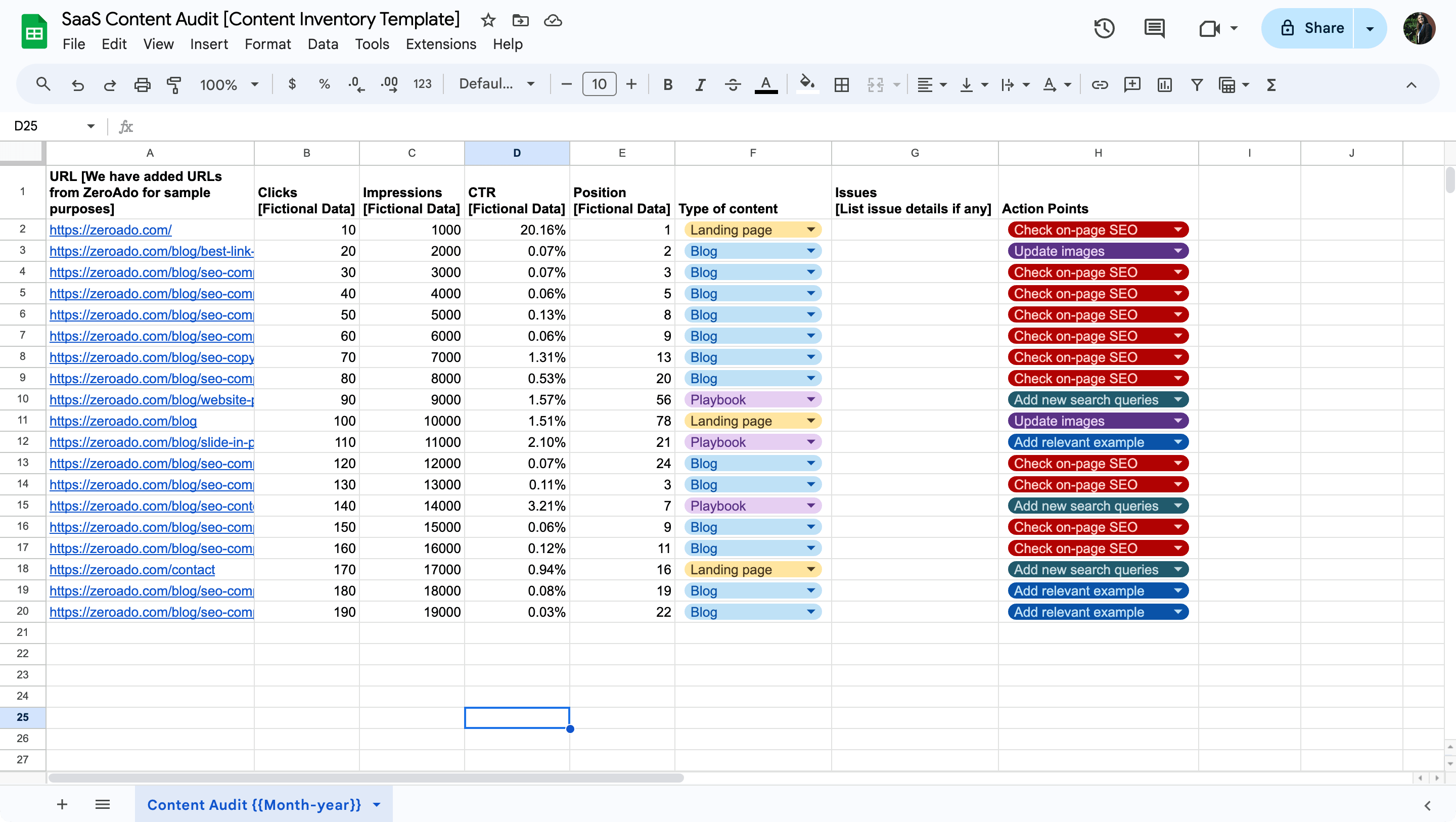
Set some broad terms to filter your content based on the action points so later you know that you have quantitative data of the number of blogs, videos, or landing pages you need to update. Keep this inventory as simple as possible and do not stuff unnecessary details.
Checkout how you can create a pivot view as well, to have better insight of all the updates you need to make. 👇
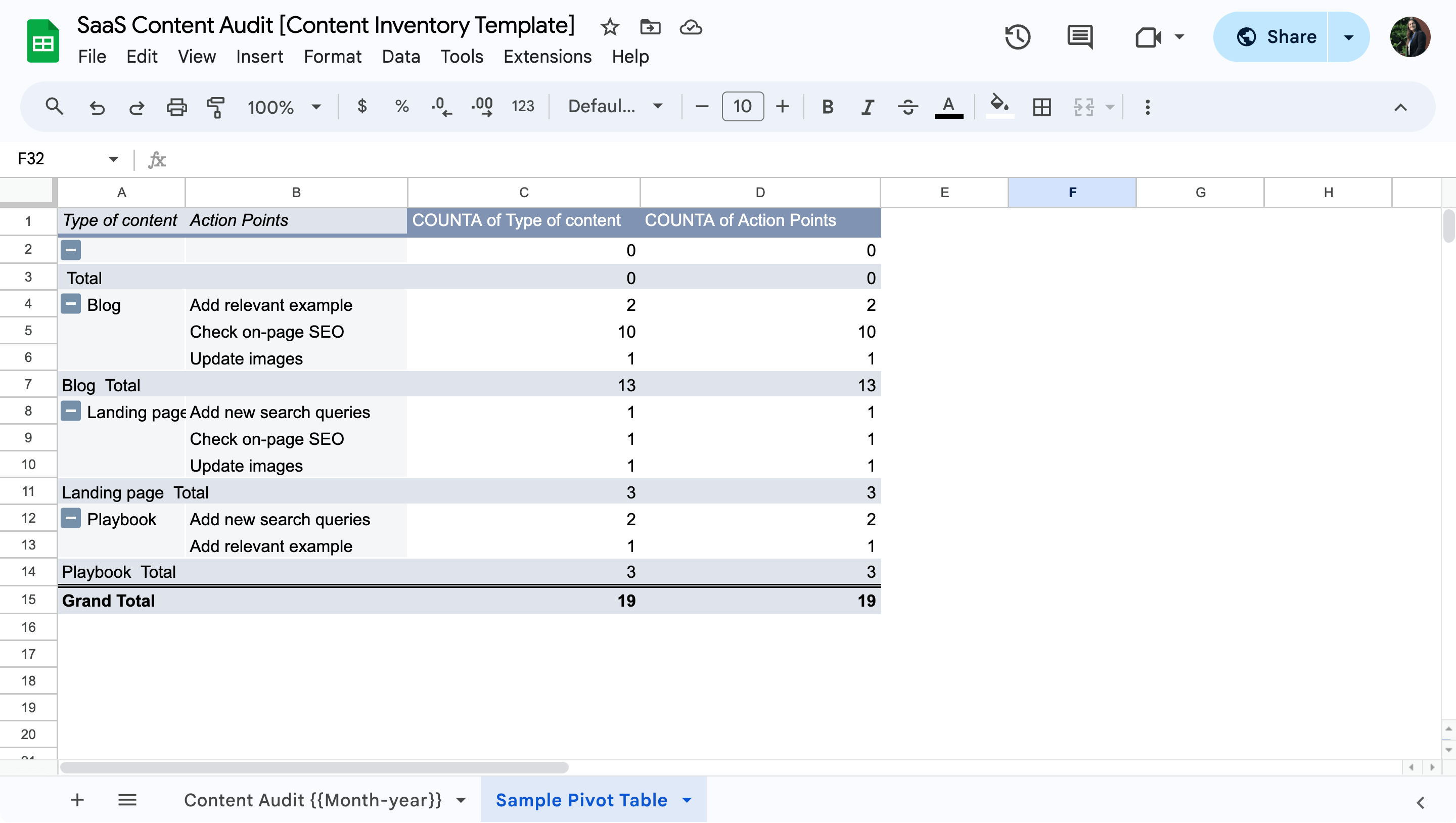
For instance, for updating blogs you can keep action points as – check on-page SEO (which sums up metadata, image SEO, and other aspects).
You will be analyzing these content pieces one by one to assign an action point to them along with the issue to be resolved. Some issues you will find instantly, for example, Ahrefs gives you a list of duplicate content which you can check and instantly assign the relevant action point.
Set priorities
Setting priorities is the most crucial part of SaaS content audit because how you prioritize your content updated will depict how fast you will see an upgrade in the content performance. For instance, blogs ranking in top 10, have higher chances of coming in top 3 with quick updates, and this will also give you instant increase in clicks and traffic as well.
So you need to then set your priorities right because 80% of the difference will be made by just 20% of the updates that you push. So keeping the traffic, position, and sign up rate in mind, prioritize your content pieces for updates.
For instance, a dip in position, or conversion rate is the biggest red flag you should notice, and then analyze why the content lost its position and then prioritize it to update.
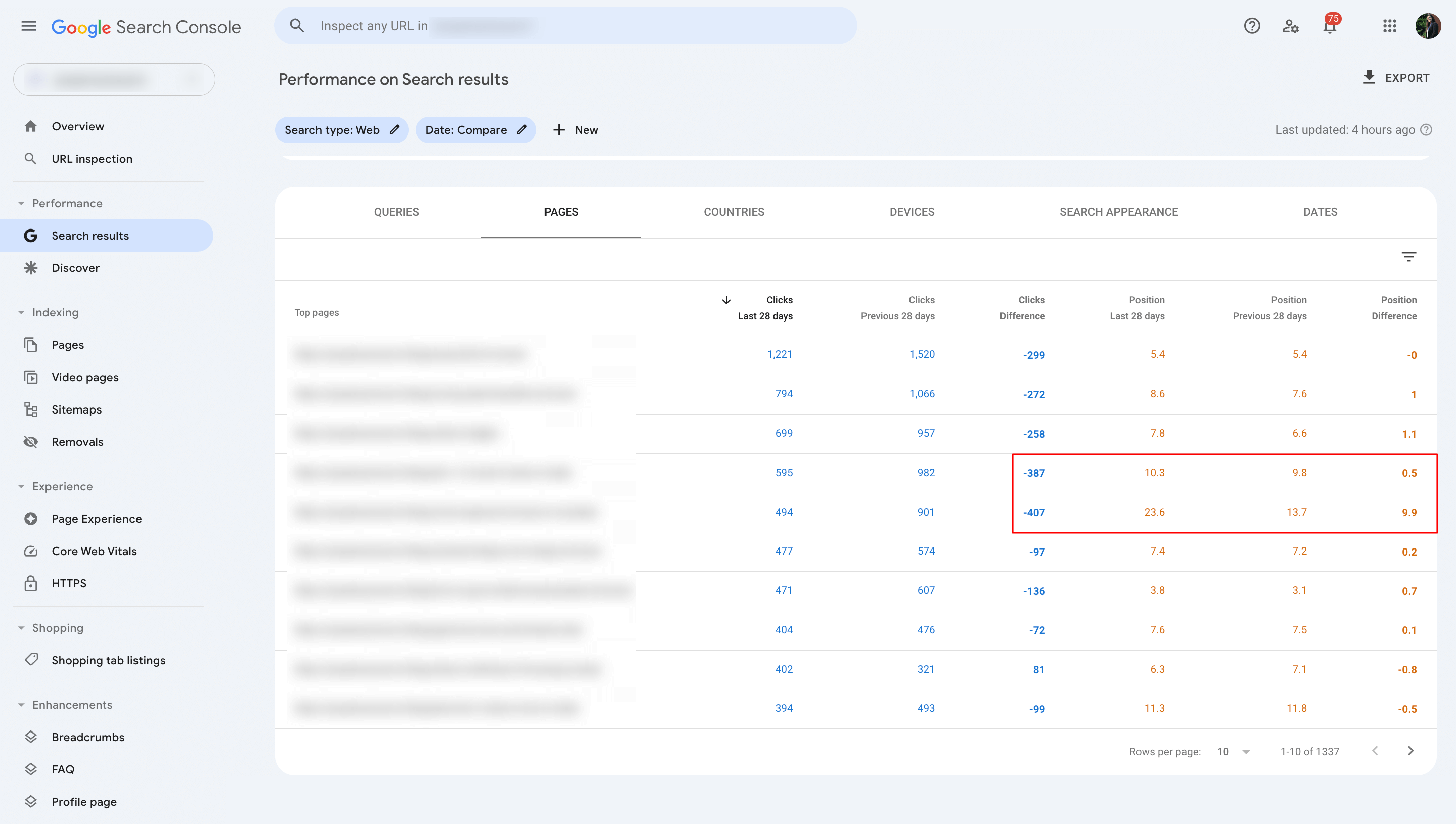
[Source – Google Search Console]
As per the above data, I would choose to update the highlighted piece of content because on one we have got almost a dip of 10 position in last month and the other was earlier on page 1 because of being at 9th position, but by a small dip, it has now been shifted to page 2 of the Google Search results, which by the way, can cause heavy loss as you can see the drastically declining click rate.
Maintain a document for detailed action points for all content types
SaaS content audit is an ongoing and detailed process. Your filterable inventory has all the action points covered under a broader term but at the ground level you need intricate details of all action points.
For that, first you must analyze the prioritized content in detail, find out things to be updated, and list them in your document to ensure that each point has been taken care of.
Here is how ZeroAdo Crew is maintaining a detailed document for its client Unrola, an AI App Store, to stay on top of the content at all times.
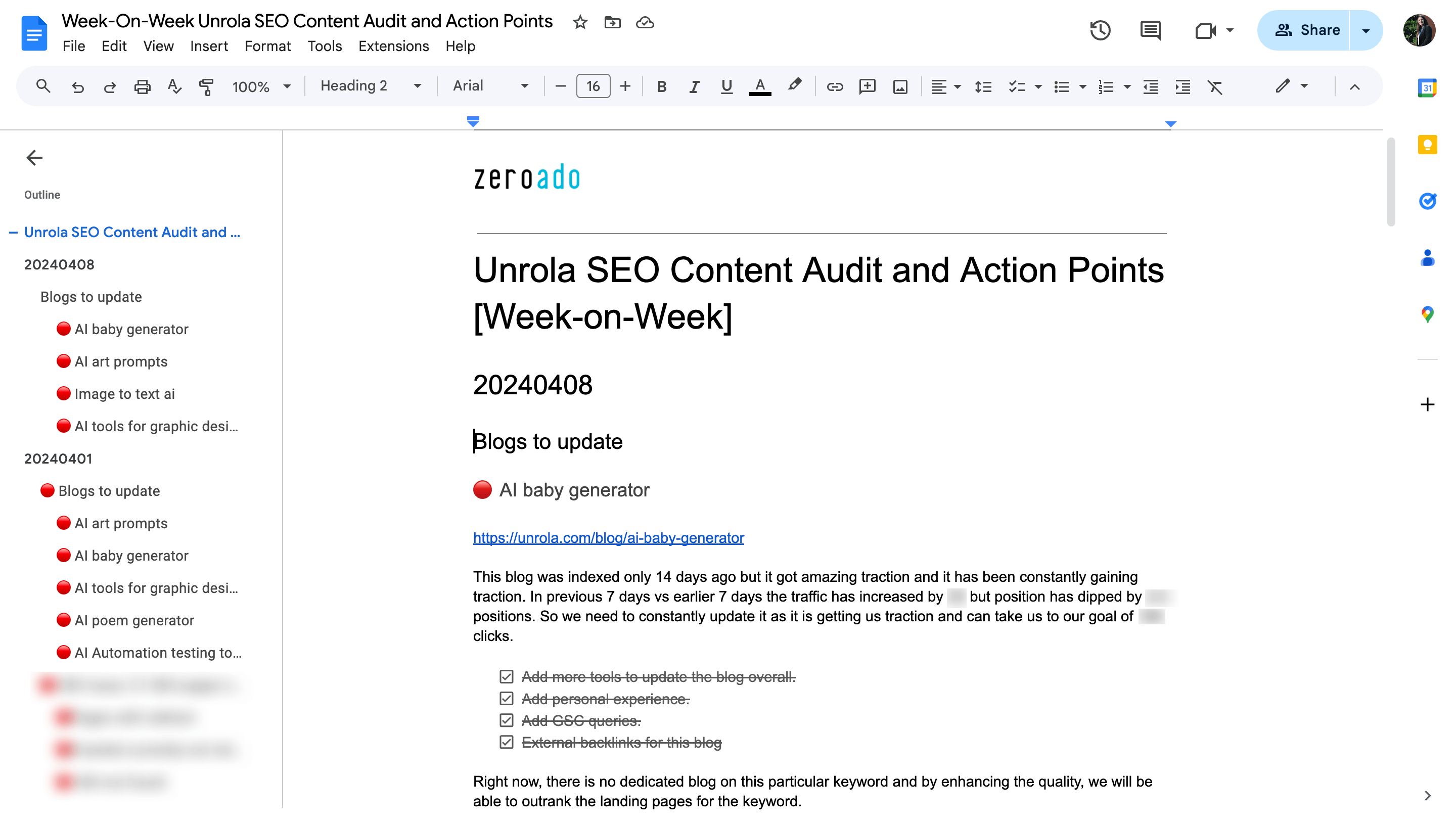
To simplify the chore for you, we have also created a template for you to maintain your document of action points. You can utilize our Content Audit Action Points Template for weekly, monthly, and even quarterly analysis.
Follow ZeroAdo’s content quality checklist
Be it the evaluation of the content you need to update or be it creating a new content piece from scratch – ZeroAdo’s Content Quality Guidelines Checklist is all that you need while doing SaaS content writing.
Make your introduction pop!
- Did you use the storytelling approach or an example to hook your audience?
- Is it crisp?
- Does your first paragraph have the contextual places keyword?
- Is it relevant to the topic and is it giving the reader the crux of what is coming next?
- Is it catering to the keyword intent?
An SEO optimized body which is also worth reading
Your body is the part of content that will be read the most, so it must give all the relevant answers as per the keyword bucket.
- Does it start with a H2?
- Does the H2 have the main keyword?
- Does it cover all the important points that the user is wondering about?
- Are headings and subheadings self explanatory?
- Does it have images and visuals to keep the content interesting as well as comprehensive?
- Does it have an ‘X’ factor (something which no other competing content piece has)?
- Does it contain internal links after every 200-250 words.
- Are internal links contextual?
- Are main and secondary keywords used contextually?
- Is it catering to the keyword search intent?
- Does it have quotes, statistics, or a unique point of view than the existing content pieces?
- Is it to the point? Nothing less and nothing more?
- Have you promoted your product contextually?
- Is the content value adding and not repetitive?
Conclude with a bang!
Closing ceremony has to be bigger than the opening ceremony to make an event unforgettable. That is also the case with your content pieces. Here is how you can ensure writing an impactful conclusion.
- Does conclusion have a proper heading and not just the word ‘Conclusion’ or ‘Final words’ written?
- Is the conclusion creating a story in-line with your topic and introduction?
- Is the conclusion less than 150 words?
- Does the conclusion have a CTA and internal link?
- Does your conclusion leave the reader longing for more or trying your product out?
SEO checks to make your content rank
- Have you given due credit to the quotes and statistics you have added?
- Is the content unique and plagiarism free?
- Have you checked if it has any spammy links?
- Did you make sure that you have not done keyword stuffing?
- Is the meta title within 50-60 characters?
- Is meta description under 156 characters?
- Do heading tags have relevant keywords?
Nail image SEO
- Did you make the image file name relevant to the topic?
- Did you add alt text for the image?
- Did you add a relevant title for the image?
- Did you give a relevant caption for the image?
- Does the image caption have a link to the source?
Enhance readability
- Are all your paragraphs of 3 or less than 3 lines?
- Did you make your content scannable by adding relevant heading tags?
- Did you use bullet points to improve readability of the content?
- Grammar check done?
That was the holy grail content quality checklist of ZeroAdo that we use for content audit for SaaS clients. This is the checklist that has worked for multiple of our SaaS clients and has helped them garner more and more organic traffic each passing day.
Checkout the organic traffic of one such client of ours – Zixflow, a sales and marketing platform. Their organic traffic’s graph have been just going upwards ever since they started implementing our content quality guidelines.
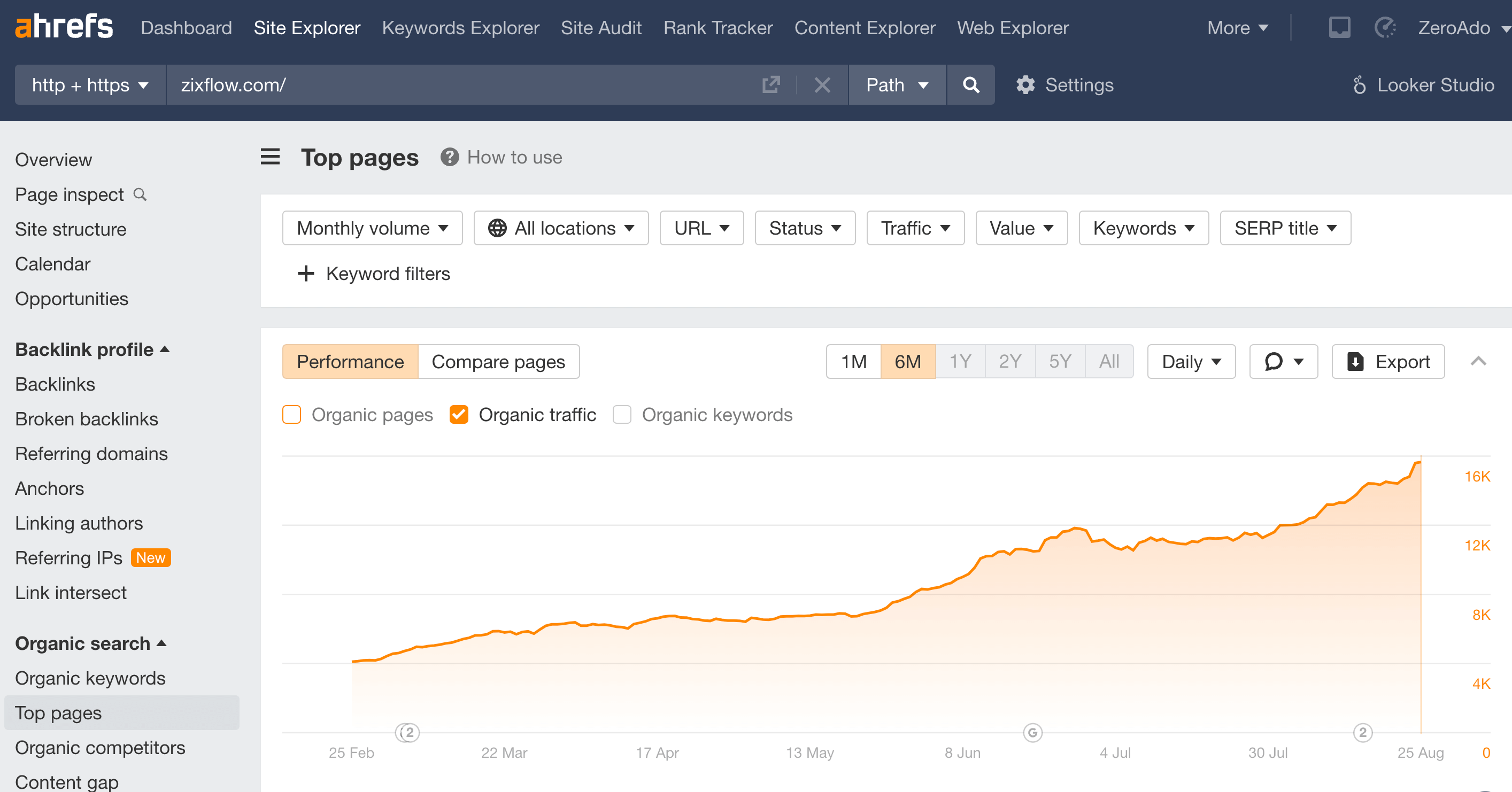
Get, set, do SaaS content audit!
| “If we are going to develop and maintain high-quality websites, we need to pay attention to the full content lifecycle – not just development, but ongoing improvement and weeding.” ― Paula Ladenburg Land, Seasoned Content Professional |
It is not an option but a necessity to keep content audits for the ultimate business success through content.
And now you have everything that you can ever need to conduct a thorough SaaS content audit for your business. So don’t waste any time and get started with it.
And if you want an easy way out yet get the most effective and detailed content audit for SaaS then contact ZeroAdo, we’ll do it all for you!
